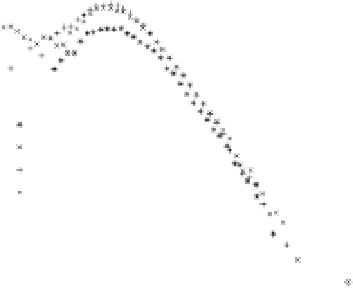Environmental Engineering Reference
In-Depth Information
Again, the variation between the individual data sets
seems to be small.
However, the comparison of rockfalls and landslides
requires some caution as different measures of event
size are used. For making the statistics comparable, it is
assumed that landslide depth is proportional to the square
root of the area, so that landslide volume increases with
landslide area raised to the power of 1.5 (Hovius
et al
.,
1997; Malamud
et al
., 2004). This immediately leads to
b
vol
=
10
1
10
0
10
−
1
10
−
2
Umbria snowmelt
Guatemala rainfall
Northridge earthquake
Taiwan historical
Bolivia historical
Japan historical
Umbria historical
New Zealand historical
10
−
3
10
−
4
2
9 for the landslide
inventories (Malamud
et al
., 2004), which is far from the
value
3
b
area
and finally to
β
vol
≈
1
.
10
−
5
07 found for rockfalls. This low value for the
exponent could only be approached by assuming a very
strong, completely unrealistic increase of landslide depth
with area.
Thus, both landslides (at least at large sizes) and rock-
falls exhibit power-law size statistics, but quantitatively,
there is a considerable difference. The smaller power law
exponent of rockfalls indicates that the relative num-
ber of large rockfalls is much larger than the relative
number of large landslides.
So landslides, rockfalls, earthquakes and forest fires
exhibit qualitatively similar size statistics, although quan-
titatively different. The striking similarity in these obvi-
ously different phenomena raises a question: is this just
a coincidence or is there any unifying concept behind
it? The idea of self-organized criticality (SOC) was intro-
duced by Per Bak and his co-workers (Bak
et al
., 1987).
Self-organized criticality has indeed become a very popu-
lar concept whenever power-law distributions arise from
dynamical systems.
SOC was discovered in computer simulations of a sim-
ple cellular automaton model, the Bak-Tang-Wiesenfeld
(BTW) model, sometimes also called the sandpile model.
The BTWmodel is usually defined on a two-dimensional,
square lattice. Each site may be occupied by a number of
grains (or any other objects: the physical context of these
objects is not important for the model). In each step, a
grain is added to a randomly chosen site. If this site still
contains nomore than three grains, nothing happens, and
another site is selected for a grain to be added. If, in con-
trast, the site contains four grains, it becomes unstable,
and these four grains are redistributed among the four
adjacent sites. Grains passing the boundaries of the model
domain are lost. Afterwards, some sites may contain four
or even more grains; they are relaxed by redistributing
four grains according to the same rule. This iterative
process may lead to avalanches of various sizes.
The BTW model was recognized to be self-organizing.
Independently from the initial condition,
β
≈
1
.
10
−
6
10
1
10
2
10
3
10
4
Landslide area [m
2
]
10
5
10
6
10
7
Figure 16.1
Frequency density of eight landslide data sets
(Hovius
et al
., 1997; Malamud
et al
., 2004).
Available rockfall inventories are much smaller than
those available for landslides. Malamud
et al
. (2004)
reanalyzed three inventories of rockfalls and rockslides
originally published by Dussauge
et al
. (2003). Each data
set consists of only 89 to 157 events compared to several
thousands in the landslide inventories. The frequency
densities are displayed in Figure 16.2. While landslide size
was measured in terms of area, volume is used here.
In contrast to the landslide statistics shown in
Figure 16.1, no obvious rollover at small sizes is visible
here. Even more important, the power-law exponent
is much smaller than that of landslides. Malamud
et al
.
(2004) suggested
β
≈
.
1
07 for rockfalls and rockslides.
10
4
10
2
10
0
10
−
2
Yosemite historical
Grenoble historical
Umbria earthquake
10
−
4
10
−
6
10
−
4
10
−
2
10
0
Rock fall/Slide volume [m
3
]
10
2
10
4
10
6
Figure 16.2
Frequency density of three rockfall inventories
(Dussauge
et al
., 2003; Malamud
et al
., 2004). The dashed line
illustrates a power law with an exponent
β
=
1
.
07.
it always
















































































Search WWH ::

Custom Search